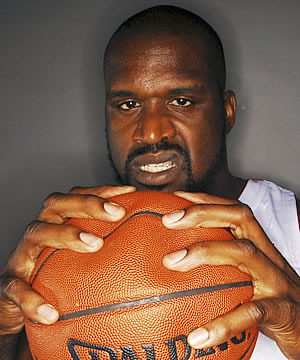Flip a coin. Heads or tails. 50-50. Half the time it will come up heads. Half the time it will come up tails.
That’s 50 percent odds, roughly the same as Shaquille O’Neal’s free-throw percentage (52.7 percent).
Pick up a coin and start flipping it over and over again, making note of the results, and you may find the occasional “hot” streak of multiple heads or tails in a row, but it would be silly to attribute this to some pattern. That’s just probability and statistics.
Similarly, over the course of Shaq’s 11,252 career free-throw attempts, there may have been occasional “hot” and “cold” streaks of multiple hits or misses in a row. But again, this is just probability and statistics.
That’s what we keep hearing in the name of “math” and “science.” And it’s nonsense.
Because, scientific fact: Shaquille O’Neal is not a coin. Or a six-sided die.
 A coin is an inanimate object. A coin is not being called on to perform a task. It lacks agency and activity. It is not attempting to do anything. Flip a coin and it is not trying to come up heads, or failing when it comes up tails. It does not remember its previous attempts and it cannot learn from them. It cannot attempt to replicate its previous successes or to correct for its previous failures. It cannot get nervous about future attempts. It cannot forget to bend its knees. It cannot overthink or underthink. It cannot wake up with a sore back or be tired from a cross-country flight the night before.
A coin is an inanimate object. A coin is not being called on to perform a task. It lacks agency and activity. It is not attempting to do anything. Flip a coin and it is not trying to come up heads, or failing when it comes up tails. It does not remember its previous attempts and it cannot learn from them. It cannot attempt to replicate its previous successes or to correct for its previous failures. It cannot get nervous about future attempts. It cannot forget to bend its knees. It cannot overthink or underthink. It cannot wake up with a sore back or be tired from a cross-country flight the night before.
Apart from the outcome of the flip — heads or tails — every other variable of the coin toss is invariable.
None of that was true for Shaq at the stripe. He was trying to make those shots. He wanted and intended and attempted to succeed. He practiced. He studied. He tried new approaches.
Every such attempt involved a host of variables — things he could do properly or improperly, successfully or unsuccessfully. Fingers, wrists, elbows, shoulders, back, waist, knees, ankles, toes, eyes, brain. Do something wrong with any of those and the attempt will fail, not because of statistics or probability, but because the attempt was performed incorrectly. Do all of those things right and the attempt will succeed — not because of statistics or probability, but because the attempt was performed correctly.
In his second-to-last season with the Lakers, Shaq succeeded in 451 of his 725 free-throw attempts — a free-throw percentage of .622. The following season, his last in LA, he had 676 chances to make a free throw and succeeded on 331 of them, for a free-throw percentage of .490.
In other words, Shaq was better at shooting free-throws in the 2002-03 season than he was during the ’03-04 season. He performed that task better. He played better. He had a better year.
The alternative, “statistical” theory says that he didn’t. There’s no such thing, it asserts, as good performance or bad performance. Those are just statistical flukes, minor variations in the overall career trend that dictates as a law of the universe that Shaquille O’Neal will make 52.7 percent of his free throws and miss 47.3 percent of them.
That claim of “statistical” predestination is confused.* We know the odds of a coin-toss or of the roll of a die before we ever pick them up. Those things are set, predetermined. But it was not preordained by the universe that Shaquille O’Neal would be a .527 free-throw shooter for his career. It’s weirdly mystical to speak of statistics that measure the outcome of an athlete’s performance over time as though they were that athlete’s “scientific” destiny.
And it’s ironic that such mysticism comes from those desperate to dismiss talk of being “in the zone” because they see that as uncomfortably mystical-sounding.
Relax. There’s nothing mystical about it.
When athletes or musicians or gamers speak of being “in the zone,” all they’re doing is describing their sensations during periods of peak performance. Those sensations and those descriptions are readily accepted in other arenas. People who have been in automobile accidents frequently describe their experience of heightened awareness, as though the world suddenly went into slow motion. Science notes the frequency of such stories as a cumulative suggestion that something is going on here that’s worth exploring. Why do accident survivors experience this sensation? What causes or accounts for this perception on the part of so many people? What is the source of this widely reported sensation?
In that case, science is willing to treat this thing as a thing to be studied. So why is it when the majority of athletes — even us not very good amateurs — describe nearly the same thing, “science” rushes to debunk and dismiss, murmuring about statistical destinies like fortune-tellers murmuring about astrological fate?
The truth is that athletic performance involves athletes performing. Unlike coins or dice, those athletes are trying to succeed. Sometimes they do. Sometimes they fail instead.
I’ve talked about free-throw shooting here because it simplifies things by eliminating defensive variables, course conditions and random luck. The task being attempted is the same every time. Success or failure depends solely on what the shooter does. It is not statistically predetermined. The universe did not decree at the beginning of time that Shaquille O’Neal would come up tails 5,317 times from the free-throw line. It wasn’t mathematical fate — Shaq just missed those shots. He did something wrong — or did several somethings wrong — on those 5,317 free-throw attempts. He missed.
And the 5,935 free throws that Shaquille O’Neal successfully made cannot be attributed to statistical destiny either. He made those shots. He stepped up to the line and did everything right.
Free-throws aren’t easy and they seem to have been especially difficult for Shaq. But there were some nights — some games, some stretches of games — where they seemed easy for him. Everything seemed to click, time seemed to slow down, the basket looked huge and he felt calm and confident. Ah, he thought, I’m going to make this. That wasn’t his retrospective description of those moments of peak performance — it was his experience of those moments in and during and just prior to those moments.
What was going on there? What allowed him to succeed, to perform so well, on those occasions?
If your answer is: “Nothing, it’s just a statistical illusion,” then what you’re really saying is that there’s no such thing as athletic performance — no such thing as bending or not-bending your knees. That seems very wrong.
– – – – – – – – – – – –
* The confusion here comes from a misunderstanding of the way sports statistics are stated. Those stats are often described as mathematical facts: George Brett is a .300 hitter. The mistake comes from interpreting that as an ontological state of nature — George Brett is a .300 hitter, so therefore over time George Brett will hit .300.
But that isn’t what the statistic means. It is an after-the-fact measure of performance, a tally that records what the actual person George Brett accomplished by swinging a bat over 21 years in a Kansas City Royals uniform. George Brett was a human agent attempting to perform a task. In 10,349 such attempts, he succeeded 3,154 times.** Therefore George Brett hit .305. He achieved that statistic, statistics didn’t ordain that for him.
** 3,155 times if we count the pine-tar homer, which I think we should even if officially we can’t.












